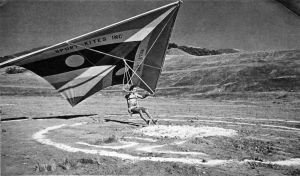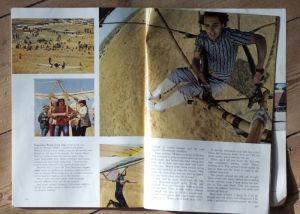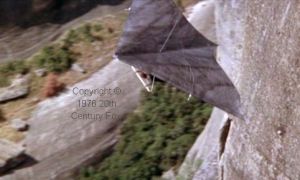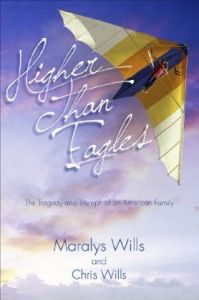Home (contents) →Miscellaneous → Eagles among men
Eagles among men
He had the look of someone who’d been sleeping under a bridge. Even from a distance we could see that his hair was long and shaggy, his posture stooped in an attitude of defeat. Across the trimmed grass he shuffled toward us, expressionless. He hardly looked like our son.
Higher than Eagles, the Tragedy and Triumph of an American Family by Maralys Wills and Chris Wills, 1992, reviewed by Everard Cunion in April 2019
Today (2019) Wills Wing is, as far as I know, the world’s longest established and largest hang glider manufacturer. Its name derives from the Wills family of southern California: Maralys, an author, Rob, a lawyer, and their six children. (Not all six involved themselves in hang gliding.) This book documents how that manufacturing business started and, as the subtitle indicates, the unimaginable distress of a mother having two sons killed in the then new activity of hang gliding.
Sport Kites
When, as an 18 year-old I took up hang gliding in 1974, Californian Bob Wills was already a household name in Britain and doubtless elsewhere, because of his record duration flight in Hawaii the previous year. (News did not travel fast in those days.) I overheard people conversing in the high street of my local town in southern England: “Did you see on the news about that Bob Wills flying for eight hours in a hand glider!” (I too thought it was hand glider at first.)
One thing that strikes me from this account is the almost ‘frontier’ live-or-die approach to life in the capitalist USA of that time, which contrasted with the contemporary assumption in Britain that, regardless of how well you did as school or college, or how bright or dim you are, or how physically able you were, the state would see to it that you lived a comfortable life on approximately a par with everyone else. (Whenever I speak of such things nowadays, others–when they have stopped laughing–remind me just how long ago the early 1970s was.) In contrast, Maralys Wills describes how the Wills’ wealthy lifestyle resulted from Rob’s profession (law) and that their second son, Chris, was the only one of their six children who did well enough at school to stand any chance of matching that lifestyle. He eventually became an orthopaedic surgeon, but not before becoming the first US hang gliding champion.
I turned the page and read aloud. “Like many hang glider fans, Richard Miller combines meticulous engineering and trash technology.” “If we do it,” Price interrupted, “it’ll sure be trash. So what’s the next move, Wills?”
— Chris Wills in Higher than Eagles
The way that the manufacturing entity Sport Kites Inc (later Wills Wing) was started is not as straight-forward as I had imagined. Unlike the smiling intellectual Chris, tall and lanky Bob with his long face (who suffered from asthma and exhibited associated behavioural problems) lacked direction in life until he discovered hang gliding, in which he had little interest at first. Chris got hold of the February 1972 edition of National Geographic. It featured articles on African wildlife, the varied lifestyles of the citizens of Maryland, the lunar rover adventures of the crew of Apollo 15, and a gathering of men of varied ages floating down a suburban hillside in Southern California while hanging on to home-made Rogallo wings made of bamboo poles taped to polythene sheet sails.
Wills Wing
The Wills brothers eventually made gliders out of more appropriate materials: Dacron sailcloth and aluminium alloy tubing with steel fittings and cables. Then they encountered Bill Bennett…
“…and I said, ‘Mate, you want to fly something good?’ and Bobby said he did, so I got one of the kites off my van. Well, he straightaway took the damn thing and almost made it talk.”
— Australian hang glider pioneer Bill Bennett quoted in Higher than Eagles
By 1973, the two eldest Wills boys, Bob and Chris, together with their friend Chris Price, had designed and built a standard Rogallo refined enough to fly at least as well as the best, and better than most. Yet it was Bob’s skill as a pilot that turned heads of spectators and drew television cameramen, news reporters, and film makers to the windy hillsides where he flew.
By the end of the first day he’d made extensive lists and ordered all the tubing, cable, Dacron, nuts, bolts, and tangs we’d need for a month’s production. At meals he told us what he was doing, so full of laughter and enthusiasm he boiled over continually. All of us – even Tracy, Kirk, and Kenny – were caught up in his enthusiasm. The new business was all we talked about, and our conversations went on into the night.
You might be surprised to hear that the foregoing is not about Bob. He was at that time away in Canada winning their championship when, unknown to him, family and friends set about creating the business as a surprise for Bob upon his return. When he arrived home, he did not react in the way they expected.
Maralys’ account of Bob’s first flight from the cliff top at Waimānalo is nerve-wracking. Nobody had flown the ‘green walls’ of Hawaii before. Then, after Bob set the eight-hour record (Chris landed to borrow a jacket, which he gave to Bob by re-launching and passing to him on a line in mid-air) Maralys describes her own flight with Bob, strapped to an extra wide seat suspended by polypropylene rope, but with no back restraint or chest strap. That narrative is so intense I found it hard to keep reading.
Then, as now, launching a hang glider in a strong wind really needs a helper on the front wires, especially on a cliff.
Eric took a quick look behind him and his eyes got big. “You don’t have to back up so far. It isn’t necessary.” Eric grinned. “’Preciate that.” Dad was back in action, tying the rope around Eric’s waist, wrapping one end hard around a bush and taking the other end himself. I picked up my kite and moved forward into the wind, trying to make sure Eric was okay.
— Chris Wills in Higher than Eagles
Chris’s launch was not good, but he got away with it – just. A photo in the book shows him seconds after that take-off, his glider banked towards the cliff with the near half of the sail luffing and Chris weight-shifting the other way, while Eric scrambles up from the cliff edge warily.
The parking lot was jammed with cars and RVs, and as we reached the flying site, colored pennants formed into long lines and cheerfully waved at the crowd. Cameras were everywhere: carried by hand, slung around necks, and the oversized variety, bearing the letters NBC, CBS, and ABC, riding sidesaddle on human shoulders.
Any new activity that attracts television and press, in addition to drawing in those who push the frontiers and who give more than they take, also attracts sharks. Hang gliding in its early days was no exception. Copying is inevitable. Indeed, copying the most successful designs and advancing on the copy is largely how improvements are made. However, at the extreme are those whose unaccountable malevolence towards the innovators dispirits the latter. The Wills family were victims of such behaviour, as were one or two pioneering British hang glider developers.
Those early days of hang gliding were dangerous. Here, Maralys describes Chris ‘Ramsey’ Price’s reaction to the death of a friend:
Then Ram said, “It’s strange, but I’m mad at him for dying. I feel like shouting at him, ‘You idiot, why did you get yourself killed?’ But he’s not here to yell at.”
That was a portent of a disaster yet to come.
Sky Riders
Maralys, unlike most authors of hang gliding histories, is a ‘people person’ rather than a technical person. (Technical expertise for the book was undoubtedly provided by Chris.) Maralys sheds a rare and much needed light on those involved at the time. This is how the young Chris ‘Ramsey’ Price, who assisted the Wills brothers in designing their early gliders including the ground-breaking Swallowtail, gained third place in the second US national championship:
…he skimmed slowly, agonizingly, inches above the ground, letting the sail carry him a foot at a time, and finally yards, on what is called “ground effect.” When at last the kite dropped him on his stomach, he’d made the outer ring of the bull’s-eye! As Ram stood up, wrapped in a smile that seemed to involve his whole body, everyone cheered and kept cheering. Ram was so genuinely, gratefully happy he appeared almost shy.
Those still among us who remember the British championships held on a range of low hills near the small Wiltshire town of Mere in August 1975 will find Maralys’ account of that competition compelling. Similarly, having seen the 20th Century Fox movie Sky Riders, which the Wills team had just finished flying for before they came to Britain, I was fascinated by the rough treatment they endured to eventually secure the contract to fly for that film. Their superior new glider, the Swallowtail, and their similarly superior flying skills compared to those who were initially front runners for that role, clinched the deal.
Maralys tells of girl friends and marriages and, eventually, of her becoming a grandmother. Things you just don’t get from hang gliding magazine articles. And a final tragedy that ends the book. (However, the story of the Wills family is continued in other books she has written since Higher than Eagles.)
Debrief
The book documents how Wills Wing started and the tragedy of Maralys and Rob having two sons killed in the process. If her story described just either one of those two facets, it would be well worth reading: Maralys is a skilled practitioner of the art of conveying emotion by telling a story with just the right words. Chris too is a great writer, whose description of his first ever flight in a bamboo and polythene hang glider had me laughing out loud. That the book describes both those aspects; historical and emotional in equally compelling language, makes Higher than Eagles essential reading for anyone who wants to understand the origins of modern hang gliding in general and the manufacturer Wills Wing in particular.
Higher than Eagles, the Tragedy and Triumph of an American Family by Maralys Wills and Chris Wills, 1992, is available in hardback and paperback.
Appendix: Soar and surrender
Soar and Surrender, subsequently re-titled Wait For the Wind, is a romantic novel by Maralys Wills. I mention it here because, even if you are not into romantic fiction or bodice rippers, this story provides insight into how Sport Kites/Wills Wing, or Whitfield Wings in the novel, started out as an early 1970s hang glider development venture run by a handful of youngsters and became the most successful hang glider manufacturer in the world.
It is fiction, but that form allows the author to get round many confounding details that make real life too complex and contradictory to assemble into a satisfying story. (As the saying goes, never let the facts get in the way of a good story!) While Higher than Eagles demonstrates that an account of real life can be immensely readable, Soar and Surrender/Wait For the Wind provides an alternative route to viewing one of humankind’s greatest adventures.
On his front walk she slowed and then stopped, studying his house as though it were remarkable. It wasn’t. Undistinguished from others on the street, it was a Califonia ranch; natural cedar shingles on the pitched roof, used-brick siding, big picture window in front. As oft-repeated, he thought, as his uniform.
— Maralys Wills, Soar and Surrender, 1987
Whether we are to read anything into the surname of the male lead, Kirk McCabe, I do not know. He is much different from Jim McCabe, played by James Coburn in the 1976 hang gliding movie Sky Riders.
Related
Bill Bennett’s Delta Wing Kites and Gliders, for which Bob Wills worked before Sport Kites and Wills Wing started (related topics menu)
Paint it black — review of the 1976 movie Sky Riders
Sport Kites/Wills Wing of California related topics menu
External links
Higher than Eagles topic by Bob Kuczewski on US Hawks Hang Gliding Association
Maralys Wills web site





